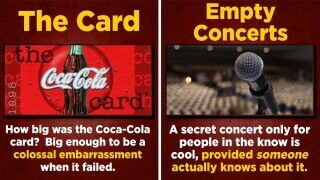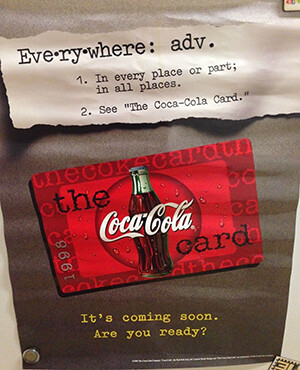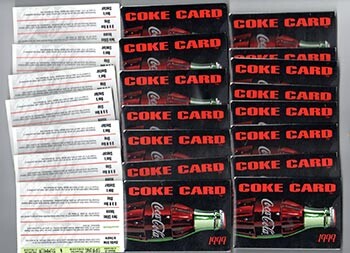5 Realities Of The Coca-Cola Card, Or The Most Confusing Marketing Campaign In History

If you think it's tough finding a bodega that accepts Discover, good luck flashing your Coca-Cola Card. One part plastic coupon, one part loyalty program, and one part baffling and logistically complex marketing campaign, Coke's late-90s attempt to get juvenile delinquents hooked on cola, consumerism, and credit cards makes the stock photo outfitted in the transparent sleeve of your wallet seem valuable, well-conceived, and worthy of your pocket space.
Widely distributed in 1998 and 1999, this forgotten relic wasn't just a glorified circular ad intended to be carried with you at all times, like a driver's license or a penicillin bracelet. But thanks to a series of vague marketing campaigns, questionable "special" offers for five-dollar haircuts, and the unshakeable feeling that being a card-carrying member of the Soda Club isn't all it's cracked up to be, here's a look at why The Coca-Cola Card's 20 ounces of fame fizzled out faster than a gas station refill.
At Least Pepsi Had a Point
Whether it's wet sandwich paper, board game railroads, or carcinogenic cash depicting a phallic Founding Camel, Americans love accumulating garbage in hopes of accumulating future garbage. In the midst of the heated "Cola Wars" between The Coca-Cola Company and PepsiCo, the only major conflict in which veterans' ailments were Type II diabetes, Pepsi's weapons of choice were Pepsi Points, which transformed standard soda bottle caps into sticky plastic currency.
Don't Miss
Through the Pepsi Stuff catalogue, plunderers could exchange a thirst-quenching 325 points for a quality Quartz watch, an ocean-polluting 575 points for a Shaqueille O'Neal-endorsed duffle bag, or 7,000,000 military-grade points for a Pepsi Harrier fighter jet in what a federal judge described as an "exaggerated adolescent fantasy" to the guy who actually thought they were seriously giving away fixed-wing combat aircraft.

Pepsi
Pepsi is said to have spent $200 million on the entire campaign, which was so successful that they eventually had to stop marketing it because too many people had claimed too many prizes. Not that I would know -- in elementary school, a classmate claimed that his dad worked for a local Pepsi bottler and promised that he'd be able to score me a free mountain bike. I'm still waiting, and out of protest I haven't had anything to drink since third grade.
Don't Leave Home Without It (Because We Only Made 55 Million of These)
Less than content with being one-upped by a brand whose identity is rooted in being the disappointing alternative to the real thing, Coca-Cola sought a proportional response that would encourage its own addicts to hoard useless plastic. The answer was The Coca-Cola Card, a wallet-friendly, red plastic opportunity available to all, regardless of FICO score or caffeine tolerance. It had the look and feel of a traditional credit card, featuring a black magnetic strip and a space for your Authorized Signature because Coca-Cola wasn't playing.

Coca Cola
Coca-Cola aggressively manufactured more than 55 million cards in hopes that one out of every five Americans would fully embrace their carbonated identities. Borrowing a page from your drug dealer, cards were peddled in high schools, pizza joints, and spring break hotspots like Daytona Beach. Three million alone were mailed directly to teens in an attempt to hook them on both junk food and junk mail. Each card was hyper-localized, offering an array of seasonal "benefits" that varied widely from town to town. There were 280 different versions of the goddamn thing, each specific to a different U.S. soda bottling territory -- which, upon a cursory glance, looks like a map of places that oppose same-sex marriage.
The card even came outfitted in its own protective cardboard sleeve, lest such a rare and valuable commodity incur damage from the elements, with a six-page fold out list that highlighted precisely where you'd be able to use the thing. If you were the kind of 10th grader who got horny over small businesses and unfurling maps, 1998 was your summer of 69.
Friends with Debatable Benefits
In theory, the $75 million campaign behind the Coca-Cola Card worked like this: you'd buy a Coke, flash your card, and earn some sort of reward. In reality, it was hard to discern who exactly accepted the card -- and whether or not the reward would be more valuable than the embarrassment you'd feel after insisting to the 7-11 clerk that you were a bonafide member of the Pop Patrol. For one thing, the vast majority of the "GREAT OFFERS" were crappy buy-one-get-one free discounts, half-price candy bars, and other pocket change enticements that were barely worthy of the time you'd spent lingering around the parking lot.

Coca Cola, via ebay
A typical deal was that of South Dakota's famed Volga Gas Stop, where cardholders who purchased a 20 oz. cola were entitled to a quarter-pound Jimmy Dean hot dog for the low price of 49 cents and an evening of abdominal pain. Some were slightly better, like the AMC Theaters in Pennsylvania that gave away a free small bag of popcorn with the purchase of a fountain Coke, which even today would cost upwards of $60.
Others remained needlessly complicated, like the offer from New Jersey's Tanger Outlet Center, which required interested parties to present both the Coke Card and a Coke bottle cap to an official at the Tanger Mall office in order to obtain a "FREE coupon book." It was the Inception of bargains; a coupon within a coupon. But instead of chatting up Leo DiCaprio and Cillian Murphy at the counter of a high-end dream bar, you were negotiating with Waldenbooks' landlord in the back office of a shopping center over how to score a cheap food court taco.
Did The Copywriter Fall Asleep On The Keyboard?
It's not just that the discounts sucked: the card was shrouded in an aura of hyped-up mystery before its disappointing release, like the Segway scooter or the Mueller report. Its vague and obtuse early marketing campaign said nothing about what the card actually did, only promising that it was "coming soon" "everywhere," seemingly bound only by the limits of time and space.

Coca Cola, via ebay
But rather than better inform the public at large that the card was a nice way to shave a few cents off of a snack, Coca-Cola doubled down in 1999 with a new marketing campaign that said even less than before called "IYDKYDG." A hard-to-pronounce acronym with the catchiness of a default password, IYDKYDG stood for "If You Don't Know, You Don't Go" and positioned itself as the antidote to typical adolescent boredom, like talking to birds in your front yard or having your best buds over to watch Julia Child during the dog days of summer.
IYDKYDG presented Coke Card carriers with the chance to attend exclusive events, including a series of secret concerts featuring the likes of Everclear, Smash Mouth, and Talib Kweli, where the price of admission was a single can of Coke. Trouble is, IYDKYDG worked so well that nobody actually knew what or where they were supposed to know or go. Recounting the tour as "the dumbest shit I ever did in my life," Kweli told Pollstar in 2003 that because nobody knew how to attend the free concerts, promoters had to stand outside and beg people on the street to attend. Even the entry-level Times Square comics hawking "free" stand-up comedy shows do a better job at disappointing strangers.
That's because, in order to find out about the concerts, Cokeheads were required to use their card to dial up a special phone number that granted access to a proprietary voice mailbox. Oh, did I forget to mention that The Coca-Cola Card was also a sprawling nationwide telecommunications project? 1999 Coke Cards included Coke Voicemail, said to be the world's largest voicemail network, which could only be accessed by purchasing a bottle of Coke and entering an 11-digit access code printed on the bottle cap.

Coca Cola
A few weeks out, Coke would blanket voicemail boxes with word of a concert, and the two dozen souls savvy enough to decipher the riddle of the Diet Sphynx would be rewarded with a concert like Kweli's. One of the more notable tour dates was a free Everclear concert in Austin, which led to assault charges against lead singer Art Alexakis and guitarist Brian Lehfeldt after they pushed away a teenage girl who had thrown a "cup full of liquid" at the band. It's also believed to have been a bottle, which would have been nice -- if it was a 20 oz Coke, they could have used its cap to leave a message for their attorney.
I think this is an important time to remind you that all of this effort was to get you to buy something that you drink on occasion.
Parting is Such Artificially Sweetened Sorrow
After two short years, Coca-Cola pulled the plug on Coke Card project, banishing the plastic to the annals of your wallet alongside your MoviePass, Magnises, and portrait of your most disappointing child. But even though the card may have been lost to the landfill of history, if its plastic legacy is anything like that of a two-liter bottle, it'll still remain with us as it decomposes over the next 450 years.

Coca Cola, via ebay
Some say the promotion was "too subtle," believing that middle schoolers didn't have a clear handle on the nuances required for effective beverage negotiations. Others believe that the card's purpose just wasn't clear enough -- teens want instant gratification, and a wild goose chase to see which convenience store had the cheapest Snickers bar simply wasn't worth the effort. Considering Coke took shots at Pepsi Stuff because not having to collect points for rewards was "refreshing," it's hard to see how obtaining bottle caps to gain access to a temporary voicemail account that may or may not tell you there's a concert happening in a fortnight was seen as a more convenient offer.
For me, what was most disappointing -- besides missing my only chance to catch Smash Mouth live without a twinge of irony -- was the card's missed potential. I carried this thing around in my wallet for two years and never found a single place that accepted it -- including Speedy Pizza, the very store I picked it up from.
My small-town suburb must have fallen in between two different bottling regions because all of the "GREAT OFFERS" were only available in adjacent or distant towns. Maybe the kids in Clarkston got to enjoy the thrill of scoring a half-priced soda for their sister, but for those of us trapped in Lake Orion, the card remained an unrequited love -- a high school handjob that came to an abrupt and unsatisfying conclusion once the bus pulled up to the commons. One of the more unsettling aspects of the promotion was that it really was just a ruse to get kids addicted to soda. Soft drink marketers made it Crystal Pepsi clear that the purpose behind promotions like these were to attract customer loyalty at "the age where brand preferences are formed." Considering childhood obesity affects 20% of this nation's children, we might as well start mailing out Coca-Cola Cards that include your Medicare number.
Today, I don't even drink soda -- the last time I had a Coke was probably in a Jack and Coke, where I mixed in the Jack to disguise the taste of the Coke. And even if you're someone who's been drinking Coke since the 90s, I don't think it's because of the Coca-Cola Card. I think it's because you love visiting the dentist.
Greg Ott (@_gregott) is a digital video producer at Cracked. He's also the host and writer of "The Latest with Greg Ott," a weekly comedy podcast about trending news and O.J. Simpson's Twitter account that's shorter than a Dave Matthews Band song.
Top image: Coca Cola, Maxim Tarasyugin/Shutterstock